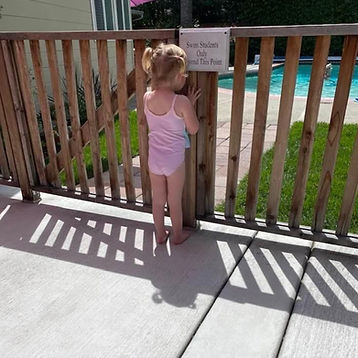

WHAT TO EXPECT

What will we do?
We will start by getting confortable in the water and with each other. Their face will be going in the water during the first lesson. Additionally we will be interacting with waterproof toys which can help distract from discomfort. For example, picking up toys from shallow steps can help to encourage children to put their heads underwater without fear.
There is no effective way to teach swimming without hands-on instruction, especially for beginners. Proper technique, particulary head positioning, is critical for safety and long term success in the water. All new swimmer instinctively try to keep theor face out of the water, which puts them in a vertical position,the very posture that leads to drowning. To break this instinct and develop correct form your child will need physical guideance. The most commonly being a steady hand on the back of the neck to encourage chin down positioning. This isn't optional. It's a foundational part of how proper swimming is taught. Even adult swimmers require this kind of correction early on,so it's entirely expected that children will too. With 7 summers of teaching and mentorship under an instructor with over 30+ years ofexperiance,I follow a tried and true method.
Tears
Yes, tears. It is very common for a child to cry during their first few swim lessons due to the new environment, fear of the pool, and separation anxiety. For children under five, crying is a common and age-appropriate way to express discomfort or uncertainty. While it can be difficult to witness as a parent, rest assured that this is a normal part of the learning process. Just like when a child cries before a nap or a doctor’s visit, protesting during swim lessons are a part of a child doing something essential for their safety and well-being. Most children will adjust by the 3rd or 4th lesson as we build trust and they become more comfortable in the water.
More information about swim anxiety can be found on the FAQs page.
No Goggles
My top priorty is teaching water safety which is why I do not allow student to wear swim goggles unless they can already make their way across the pool without them. Whether in open water or at a public pool, children may not always have their goggles on. In an emergency situation, such as falling into a pool or off a boat a child taught to swim without them is better equipped to navigate and orient themselves in various water conditions. By learning to swim without them, they’re better prepared for any situation where they need to swim without the aid of extra equipment.
Sunscreen
I ask that sunscreen be applied at least 30 minutes prior to the lessons. If the sunscreen isn't completly absorbed into the skin it ends up washing off into the water and then into your child's eyes.
Swim Diapers
Young ones who are still in diapers need to be wearing a swim diaper.
Pool Temperature
The pool needs to be heated to at least 86 degrees. Ideally for children 4 or younger the pool should be heated to 88 degrees.
More swim information can be found on the FAQ page.
